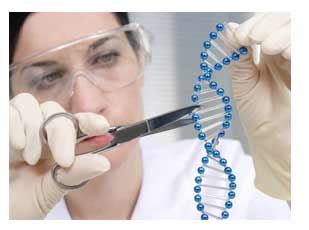 We all know that we can cut and engineer our DNA or DNA of any other organism. But, so far the methods used for DNA cutting are not precise.
We all know that we can cut and engineer our DNA or DNA of any other organism. But, so far the methods used for DNA cutting are not precise.
Available techniques:
By the older method, the genes are added into the cell and they get inserted into the genome of the cell in a random manner. This can’t be used when our aim is to engineer the DNA at a specific site and here we can’t also replace the already existing gene with our gene.
There is homologous recombination method, but unfortunately natural recombination won’t occur in cells that easily!
There are also methods which use Zinc fingers for delivering nucleases which cuts the DNA, but, this is really hard, because nuclease can’t target every possible DNA sequence. This is costly too.
TALENs – Transcription Activator Like Effector Nucleases – cut the DNA at specific location. But, what to do, this is also costly!
Here, we are going to use the already existing proteins of bacteria and RNA. The tool contains RNA sequence with the nuclease called cas9.
Here, RNA is used for recognising the site on the genome where we have to make a cut and Cas9 for cutting! The Cas9 get activated once the RNA finds exact match. It won’t get activated, even if there is a single residue difference.
Here, RNA is used for recognising the site on the genome where we have to make a cut and Cas9 for cutting! The Cas9 get activated once the RNA finds exact match. It won’t get activated, even if there is a single residue difference.
If we are willing to replace the already existing sequence with new one, we have to provide a DNA template.
This is not costly, yet effective and precise!
This is a good news for all Genetic Engineers, right? Even, I’m happy about this as a GE student, then for sure this is going to be a boon for Genetic Engineers.
After all, as my professor said, Playing with genes is the real fun! J

Random browsing took me here :) Nice write-ups about various biotech related stuff, I could learn some new things.
ReplyDeleteI am not a biotech guy, but, from what I know, I would like to post some details here. As a biotech student, you may be knowing it already.
DNA can be precisely cut using Restriction Enzymes. For example, you have mentioned TALENs, which are artificial restriction enzymes. Restriction enzymes make a cut at a specific place on both the bases of a ds-DNA, thus making some engineering possible. Restriction enzymes are available naturally and as far as I know, are not very expensive.
What you are discussing here seem to focus more about Genome editing with engineered nucleases, which generally are artificially engineered nucleases. I know nothing about these artificially engineered nucleases, but came to know something about it from your blog.
Have a good day!!!
Actually this is not for performing invitro recombination like using enzymes like E.coR1 and ligases for cloning. This is for modifying the genome of humans or other mammals for knocking out genes which could cause diseases.
ReplyDeleteThe enzyme here mentioned is a natural one available in Bacteria - this enzyme is generally used by the bacteria for protecting itself from viral infections.
Here we are using that enzyme in addition to that we are adding RNA sequence for recognising the sequences (where we have to make a cut).
Hope you got it and I believe I understood the mechanism and explained it right!
Thanks for sharing.
@Kanmani: Thanks for the details. I got your point, actually, your first few lines of introduction to the topic saying that "methods available so far to cut DNA are not precise" made me write about restriction enzymes.
ReplyDeleteOh, may be! Sorry for the inconvenience.
Delete